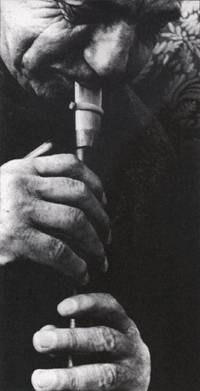 |
Djivan Gasparyan: Armenian Rhapsody
from Wire, September 1998
by Julian Cowley
[archived here without permission]
 For a long time, Armenian music meant Aram Khachaturian or the prolific Armenian-American composer, Alan Hovhaness. Then, in 1989, Brian Eno's enthusiasm for I Will Not Be Sad In This World, a recording first issued in the Soviet Union, brought the name of Djivan Gasparyan into view.
For a long time, Armenian music meant Aram Khachaturian or the prolific Armenian-American composer, Alan Hovhaness. Then, in 1989, Brian Eno's enthusiasm for I Will Not Be Sad In This World, a recording first issued in the Soviet Union, brought the name of Djivan Gasparyan into view.
Gasparyan is master of the duduk, an ancient woodwind instrument, whose sound provides a direct connection to Armenia's distant, pre-Christian past. Rarely can a musician have achieved such total identification with an instrument. Since he started to play at the age of six, he has grown to become its custodian and its champion. Now 70, he continues to explore new avenues for duduk music.
In a telephone conversation with Gasparyan in Armenia, with his daughter Narine acting as translator, he stresses that the duduk is the quintessential Armenian instrument. In effect, he says, it provides the nation's voice, and in the eight yeras since his country declared independence from the disintegrating Soviet Union, that role has proved crucial. Gasparyan says he has never regarded his own role as simple conservation; it is clear that he views music as an adventure.
Exposure in the West has had some unexpected offshoots. Lionel Ritchie was so moved by the sound of the instument that he invited the virtuoso to play on his song "Now You Are Gone." Gasparyan's daughter notes that this collaboration remains a source of pride for many Armenians. More signigicantly for Gasparyan, he formed an alliance with Michael Brook, who acted as producer for the 1993 album Moon Shines at Night, and shares credits as composer and performer on the latest project, Black Rock.
On Black Rock, the richly sinuous music of the oboe-like duduk, fashioned from apricot wood, is perfectly at home in an electronic environment of guitars and keyboards. Gasparyan says that he adapted his technique, in consultation with Brook, to make the sound "more interesting," and he is delighted with the result. But although he talks of the recording as "a new category of music, which extablishes its own standard," he claims the melodies convey "a pure Armenian sound."
The compositional process involved improvisation upon traditional melodic materials. A high level of mutual trust between the musicians is evident in the remarkably discreet and sympathetic contexts which Brook and his fellow musicians generate for the duduk's ancient sound. Also an accomplished folk singer, Gasparyan's voice appears equally at ease in these surroundings.
The intrinsic range of the duduk is limited; the instrument requires nuanced expertise to realise its expressive potential. Gasparyan has furthered its possibilities by inventing a bass version. But, as Narine says, her father has accomplished far more, in effect, he has redefined the instrument, restoring its centrality within the conciousness of the Armenian people. 50 years ago, he signalled his commitment to folk tradition by joining the national song and dance ensemble. Yet in the same year he had his first professional engagement as soloist with The Armenian Philharmonic Orchestra. The status of the duduk as a concert instrument underwnet radical revision in his hands.
In recognition, I'm told, he received the title of People's Artist of Armenia in 1973. It might sound alien from a Western perspective, but in Eastern Europe gold medals won in international competitions are a genuine testimony to his eminence.
Gasparyan derives great pleasure from the popularity the duduk now enjoys at home. He says he is confident that his new project, initially directed Westwards, would win Armenian approval. He is currently preparing to record four pieces written for a quartet of duduks and the 100 voices of The Armenian Academy Choir. Another cherished project involves a large orchestra of duduks, featuring his many students.
In October, Gasparyan goes to Los Angeles to perform at its first Armenian music festival. He is no stranger to the city, which has a sizeable expatriate community. Indeed, he says, in recent years he has been welcomed in Hollywood, where he has contributed to the soundtracks of films like The Crow and The Russia House. He makes it clear that, of his many and diverse musical experiences, he values his special kinship with Michael Brook, Brian Eno, and Peter Gabriel. After all, these are three facilitators who share his open and adventurous spirit.